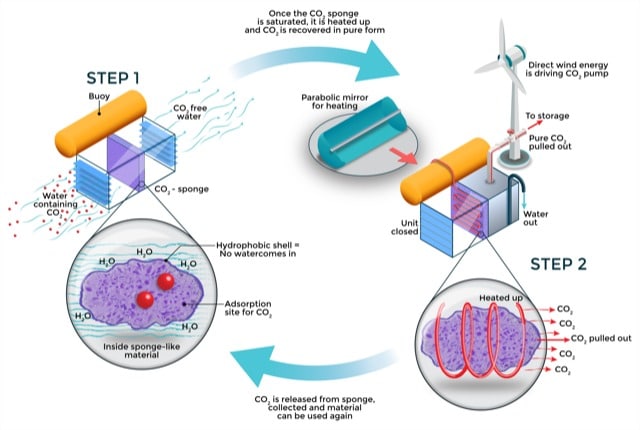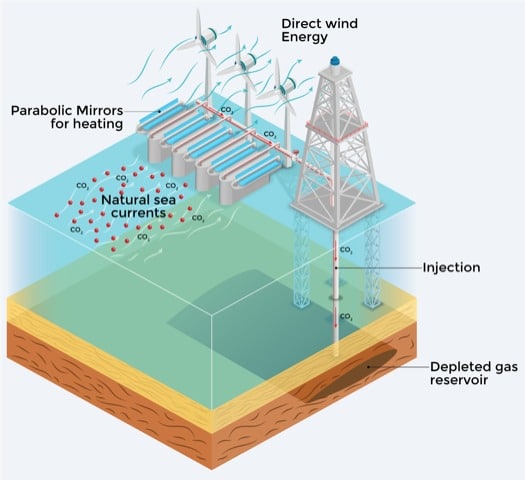The time is ripe for innovative solutions to the climate emergency, and carbon capture is a sector with high potential. Here, we present Out of the Blue‘s novel proposition for a system that could take CO2 directly from the ocean, in a more efficient way than from the air.
Earth.Org takes a closer look.
—
Global efforts to decarbonize our society are intensifying, and encouraging goals have been set for mid-century. However, even the most ambitious of these is too little to prevent 2°C global warming, the consequences of which are highly undesirable. There is therefore a demand for carbon capturing technologies that would allow us to essentially create negative emissions.
In an ideal world, we would stop emissions as soon as possible, then begin undoing the damage by removing the carbon we’ve emitted for the past 200 years or so. Unfortunately, while carbon capture is entirely feasible, it suffers from lack of scalability and affordability. It is certainly not good enough to allow it to continue as we have.
Current tech focuses on recapturing the emissions from biofuel combustion, where the carbon is caught and pumped far underground into old oil and gas reservoirs or saline aquifers. Another approach is reinforcing the natural processes that act as carbon sinks through forest restoration or rock weathering. The problem is that these require more land than we have to fix the situation, as does carbon capture from biofuel.
There is growing investment in innovative carbon capture technologies that tackle the problem from a different angle. One such idea is that of Out of the Blue, a start-up whose mission is to remove CO2 from the ocean in a safe, cost-effective and scalable manner. It was founded by Lennart Joos, a chemical engineer who went from academia (UC Berkeley, EPFL), to industry (TOTAL, Umicore), to creating his own startup. He explains that innovation has always been one of his core drivers, and after years fighting climate change he has formulated a viable solution.
As you may know, the world’s oceans absorb nearly a third of our carbon emissions along with much of the excess atmospheric heat these produce. CO2 dissolves into carbonic acid once in the water, driving up oceanic acidity and hampering animal shell-formation. Phytoplankton, one of the main carbon sinks in the ocean, need these shells to survive, which means that runaway acidity levels will massively lessen the ocean’s carbon capacity. It is therefore just as beneficial to extract carbon from the ocean than it is to do so from the atmosphere.
Let’s look at the technology in more detail.

Source: Out of the Blue.
A carbon-binding sponge material is suspended just under the water surface in a container that allows carbon-loaded water to sift through unidirectionally. Once the sponge is saturated, the container is closed off and heated, upon which the carbon is released, leaving the sponge available for reuse (potentially several thousand times). Ideally, a renewable energy source is used, like a mirror for heating or direct wind energy for pumping the CO2 out. Once collected, the gas can be sequestered as is already done with existing carbon capture technology.
The reusable nature of the apparatus along with its low operating costs (just place it there and water movement does the rest) make it economically attractive. On top of this, other ocean-based renewables (like wave power) are gaining traction and could possibly fill Out of the Blue’s energetic needs.
The ideal deployment for this technology is to harness it to pre-existing drilling platforms with access to depleted gas reservoirs, thus integrating the full process of capture to sequestration into a single system.

Source: Out of the Blue.
It must be stressed that Out of the Blue is still in its infancy, but we at Earth.Org support the research and development of climate solutions, and believe our readers can benefit from hearing about these endeavors.
If you are or know anyone who is working on innovative solutions, please get in touch via our contact email address and let us know!
This article was written by Owen Mulhern
You might also like: Why Do Some Not Perceive Climate Change as a Crisis?










![The Statistics of Biodiversity Loss [2020 WWF Report]](https://u4d2z7k9.rocketcdn.me/wp-content/uploads/2020/12/lprwinkyTHB-544x306.jpg)





